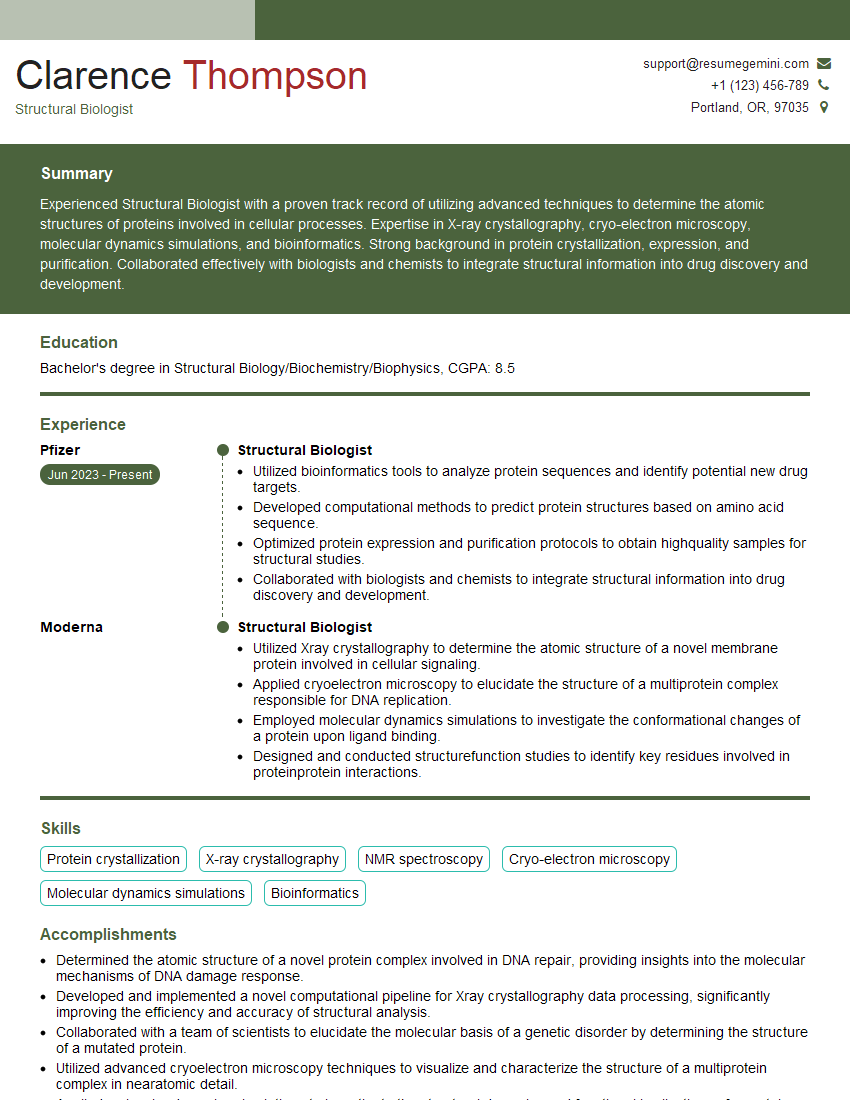Are you a seasoned Structural Biologist seeking a new career path? Discover our professionally built Structural Biologist Resume Template. This time-saving tool provides a solid foundation for your job search. Simply click “Edit Resume” to customize it with your unique experiences and achievements. Customize fonts and colors to match your personal style and increase your chances of landing your dream job. Explore more Resume Templates for additional options.

Clarence Thompson
Structural Biologist
Summary
Experienced Structural Biologist with a proven track record of utilizing advanced techniques to determine the atomic structures of proteins involved in cellular processes. Expertise in X-ray crystallography, cryo-electron microscopy, molecular dynamics simulations, and bioinformatics. Strong background in protein crystallization, expression, and purification. Collaborated effectively with biologists and chemists to integrate structural information into drug discovery and development.
Education
Bachelor’s degree in Structural Biology/Biochemistry/Biophysics
May 2019
Skills
- Protein crystallization
- X-ray crystallography
- NMR spectroscopy
- Cryo-electron microscopy
- Molecular dynamics simulations
- Bioinformatics
Work Experience
Structural Biologist
- Utilized bioinformatics tools to analyze protein sequences and identify potential new drug targets.
- Developed computational methods to predict protein structures based on amino acid sequence.
- Optimized protein expression and purification protocols to obtain highquality samples for structural studies.
- Collaborated with biologists and chemists to integrate structural information into drug discovery and development.
Structural Biologist
- Utilized Xray crystallography to determine the atomic structure of a novel membrane protein involved in cellular signaling.
- Applied cryoelectron microscopy to elucidate the structure of a multiprotein complex responsible for DNA replication.
- Employed molecular dynamics simulations to investigate the conformational changes of a protein upon ligand binding.
- Designed and conducted structurefunction studies to identify key residues involved in proteinprotein interactions.
Accomplishments
- Determined the atomic structure of a novel protein complex involved in DNA repair, providing insights into the molecular mechanisms of DNA damage response.
- Developed and implemented a novel computational pipeline for Xray crystallography data processing, significantly improving the efficiency and accuracy of structural analysis.
- Collaborated with a team of scientists to elucidate the molecular basis of a genetic disorder by determining the structure of a mutated protein.
- Utilized advanced cryoelectron microscopy techniques to visualize and characterize the structure of a multiprotein complex in nearatomic detail.
- Applied molecular dynamics simulations to investigate the structural dynamics and functional implications of a protein involved in cell signaling pathways.
Awards
- Recipient of the Young Investigator Award from the Protein Society for outstanding contributions to the field of structural biology.
- Awarded the NIH Directors New Innovator Award for groundbreaking research in protein structure and function.
- Honored with the American Crystallographic Associations Max Perutz Prize for advancements in crystallographybased structural biology.
- Received the Structural Biology Young Scientist Award from the Gordon Research Conferences for innovative work in membrane protein structure determination.
Certificates
- Protein Crystallography Certification (PCC)
- NMR Spectroscopy Certification (NSC)
- Cryo-Electron Microscopy Certification (CEC)
- Molecular Dynamics Simulations Certification (MDSC)
Career Expert Tips:
- Select the ideal resume template to showcase your professional experience effectively.
- Master the art of resume writing to highlight your unique qualifications and achievements.
- Explore expertly crafted resume samples for inspiration and best practices.
- Build your best resume for free this new year with ResumeGemini. Enjoy exclusive discounts on ATS optimized resume templates.
How To Write Resume For Structural Biologist
- Highlight your expertise in advanced structural biology techniques, such as X-ray crystallography, cryo-EM, and molecular dynamics simulations.
- Showcase your ability to integrate structural information into drug discovery and development.
- Quantify your accomplishments whenever possible, using metrics such as the number of structures solved or the impact of your work on drug development.
- Tailor your resume to the specific job description, highlighting the skills and experience that are most relevant to the position.
Essential Experience Highlights for a Strong Structural Biologist Resume
- Utilized X-ray crystallography to determine the atomic structure of novel membrane proteins involved in cellular signaling.
- Applied cryo-electron microscopy to elucidate the structure of multiprotein complexes responsible for DNA replication.
- Employed molecular dynamics simulations to investigate the conformational changes of proteins upon ligand binding.
- Designed and conducted structure-function studies to identify key residues involved in protein-protein interactions
- Utilized bioinformatics tools to analyze protein sequences and identify potential new drug targets.
- Developed computational methods to predict protein structures based on amino acid sequence.
- Collaborated with biologists and chemists to integrate structural information into drug discovery and development.
Frequently Asked Questions (FAQ’s) For Structural Biologist
What is the role of a Structural Biologist?
Structural Biologists use advanced techniques to determine the atomic structures of proteins and other biological molecules. This information is essential for understanding how these molecules function and for designing new drugs and therapies.
What are the qualifications to become a Structural Biologist?
A Bachelor’s degree in Structural Biology, Biochemistry, Biophysics, or a related field is typically required. Strong analytical and problem-solving skills, as well as experience with structural biology techniques, are also essential.
What are the career prospects for Structural Biologists?
Structural Biologists are in high demand in academia, industry, and government. They can work in drug discovery, protein engineering, and other fields related to biotechnology and medicine.
What are the challenges faced by Structural Biologists?
One of the biggest challenges faced by Structural Biologists is obtaining high-quality samples of proteins for structural studies. Additionally, the interpretation of structural data can be complex and time-consuming.
What are the advancements in the field of Structural Biology?
Recent advancements in cryo-EM and computational methods have significantly improved the resolution and accuracy of protein structures. These advancements are leading to new insights into the structure and function of biological molecules.